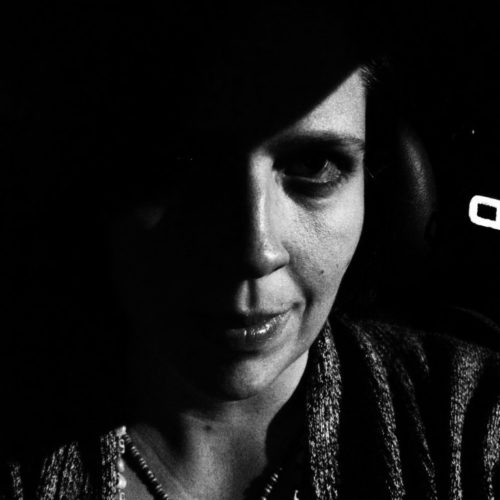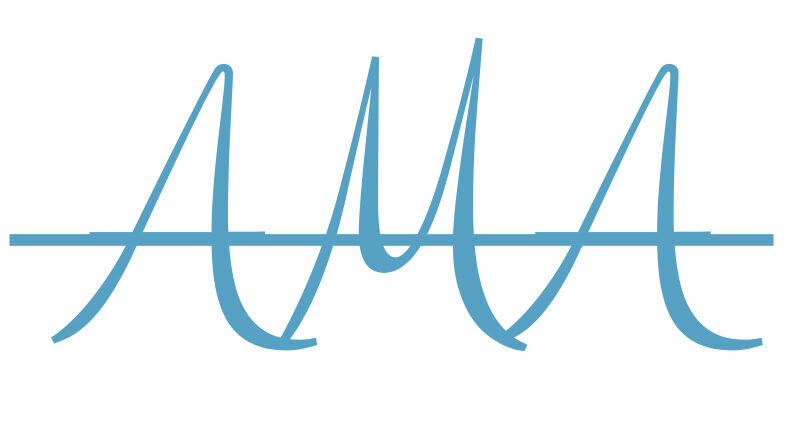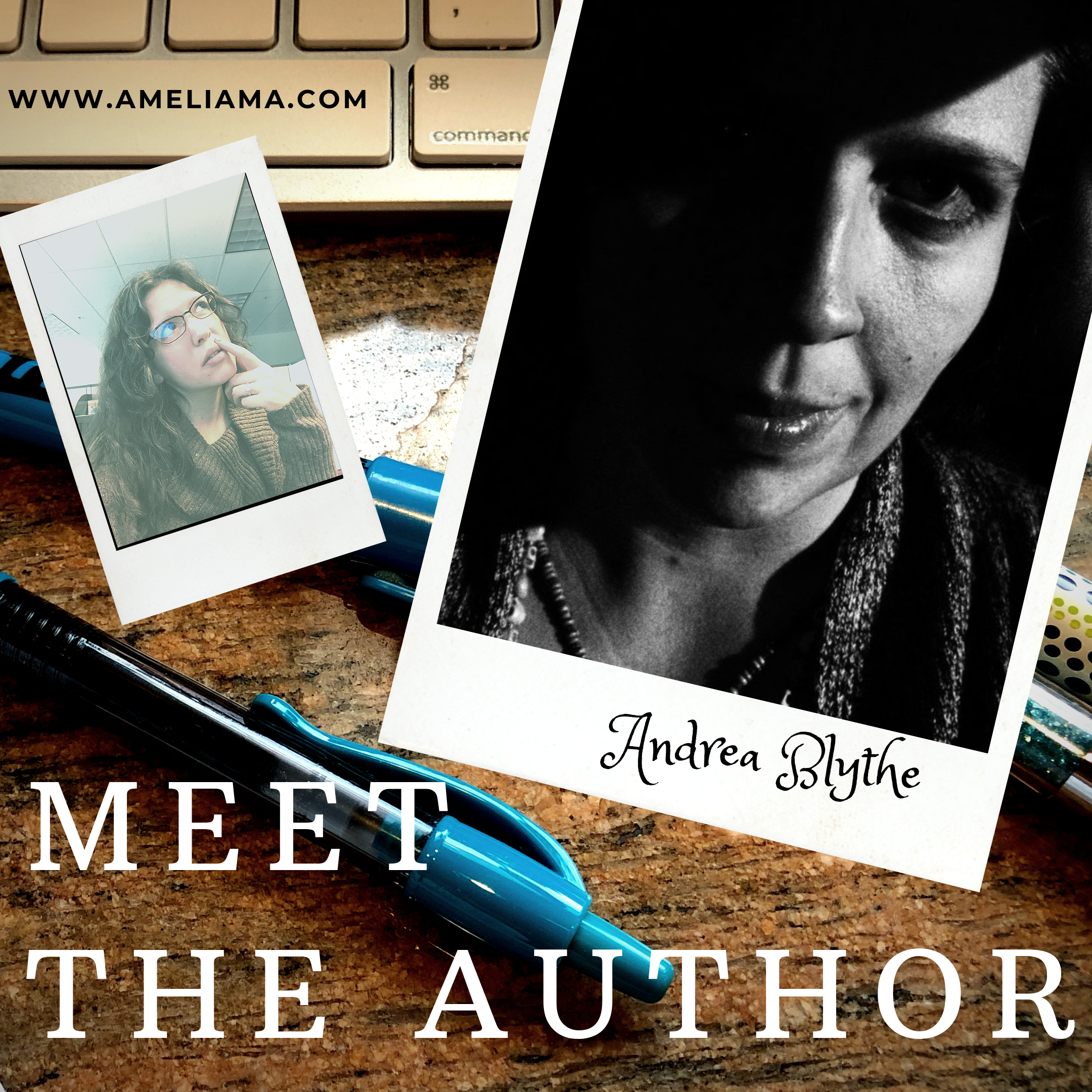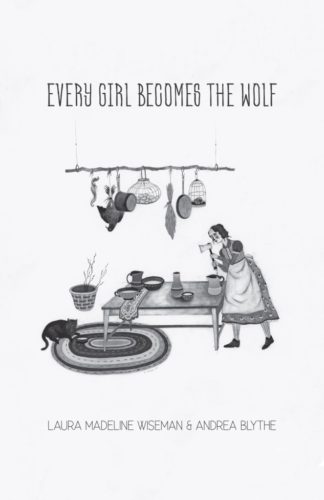Welcome to another author interview on the Meet the Author Series with yours truly, Amelia Albanese. Meet Andrea Blythe.
Blythe is an author who bides her time waiting for the apocalypse by writing speculative poetry and fiction. She is the author of Your Molten Heart / A Seed to Hatch (2018) a collection of erasure poems created from the pages of Trader Joe’s Fearless Flyers. Blythe is also the coauthor of Every Girl Becomes the Wolf (Finishing Line Press, 2018), a collaborative chapbook written with Laura Madeline Wiseman. She is a co-host of the New Books in Poetry podcast and is a member of the Science Fiction and Fantasy Poetry Association and the Horror Writers Association. Learn more at: www.andreablythe.com
1. AMA: Your website reveals that you are an avid reader with an affinity for writing. Did you always want to be a writer? Has writing always been a passion that you wanted to pursue?
AB: I was always reading as a kid — to the point that my mom rarely worried about what I was up to, since she could safely assume I would be tucked away somewhere with a book in my hands.
The concept of becoming a writer wasn’t something that I ever imagined as a kid though. My dreams mainly fell on growing up to be an artist. I loved drawing and thought that would be my future — until high school art class when I came to the epiphany that I did not have the dedication to pursue art as a career. Real artists spent hours developing their skills and craft, but for me, drawing and illustration was more of just a fun pastime.
At around the same time, I was becoming more and more inspired by language through the English classes I was taking and had begun exploring creative writing through Speech and Debate Club. Suddenly, I was aware that it was possible to make a career out of being a person who writes things — and as someone who has had a lifelong love for books and stories, this seemed to be an ideal way to make a living.
Of course, I had no idea exactly how hard it would be.
2. AMA: You dabble writing in fairy tale retellings, thrillers, poems, etc. What is your favorite genre to write? Why?
AB: If I had my way, I would write all the things — poetry, fiction, movie screenplays, video games, you name it — in a variety of genres. But I would say sandbox mostly consists of fantasy and folklore with a smattering of science fiction and horror. Tonally, I’m drawn to the day-to-day human experience of the fantastical, how one person’s strange is another person’s normal, and the dark, unsettling sides of the universe.
3. AMA: What is your favorite book or series that you’ve written so far (published or unpublished)?
AB: I particularly love the work I’ve done with Laura Madeline Wiseman, both the poetry that’s been published and the poetry that we have in progress. She continually surprises me with her skill and wisdom and I feel as though writing alongside her elevates me as a writer.
Out of my solo work, I’m not so sure. I’m proud of the work I have out in the world, but it’s my current works in progress that I’m holding the most love for — maybe because imagination allows me to envision them much shinier than the reality of the completed works in front of me. I keep struggling through my novel and the new poetry collections I’m finishing, because I believe in the potential of what they could become.
4. AMA: What is your process for writing a story or poem? How do you get inspired and begin creating a new work?
AB: Each piece is a little bit different and how I work changes over time. Lately, I’ve been doing a lot of my work on the computer, taking the initial sliver of an idea — an image or a turn of phrase — and free writing my way through a draft or the skeleton of a draft, just to learn where I’m hoping to go with a piece. After that, I do a lot of edits, often starting over from scratch the first few times I rework it until the structure suits my needs. Finally, I’ll print out copies of the story or poem and use a pen to polish for language and tone. Draft after draft after draft, until I force myself to send it out to journals or publishers.
5. AMA: Erasure poetry is not that common (at least, I’d never heard of it before your book). What intrigued you to write such a creative work, like YOUR MOLTEN HEART/A SEED TO HATCH?
AB: Erasure poetry has become more and more popular in the poetry community over the years, but my first introduction to erasure poetry was when I checked out Mary Rueffle’s A Little White Shadow from the library over a decade ago. In her book, she used white out to create poems from an old nineteenth century book. I was enchanted by the style, the way new meaning could be drawn up out of an old text, and how the erased words felt like ghosts in the background.
I didn’t start creating my own erasure poetry until I discovered Newspaper Blackout by Austen Kleon years later. He was pulling these amazing short poems from newspaper clippings, and it showed me that it was possible to come at the idea from different angles. I became inspired to begin playing with the form on my own.
Your Molten Heart came out of that sense of free play with words. I had been receiving copies of the Trader Joe’s Fearless Flyers in the mail. The flyers are essentially product descriptions of what’s available in the grocery store — but Trader Joe’s put its own witty personality into the descriptions. Rather than throwing them out, I started doing blackouts on the pages and sharing them on Instagram. At first, I had no idea it was going to turn into a book, but the more I played with it, the more it felt like that was what these pieces were meant to be.
6. AMA: Is erasure poetry easier or harder to create than any other poem? What’s your process in refining such a piece?
AB: Each poem’s form is its own unique challenge. On the surface, free verse seems like it should be the easiest form to write, since there are almost no rules regarding style, number of lines, stanza breaks, or so on. Anything goes — and that freedom can be difficult in its own right, because it can be hard to know the right direction to go, or even where to start or end. I’ve spent years editing and reediting a single poem, trying to figure out how to make it work.
On the other hand, erasure poetry is freeing in its restrictions. You only have access to the words on the page and (unless you want to draw arrows to show the reading direction) you need to use those words in the poem from top to bottom. I enjoy the challenge of figuring out how to draw a poem out of a text, which feels like a puzzle as much as it feels like writing. It works my brain in a different way and frees me up to engage with words and language in a way I wouldn’t normally.
There’s also not much editing involved in erasure. If you’re using permanent marker, then once a word is gone, it’s gone. You also can’t add or change words that are not already on the page. The only way to refine is to erase more words.
7. AMA: What book(s) have you read that inspire you the most as a writer? What makes them so inspirational?
AB: Pretty much everything I’ve read has inspired me in some way, although I’m most moved by works that make me feel humbled as a writer and make me want to strive to do better. This includes fiction books like Imaginary Girls by Nova Ren Suma, Ancillary Justice by Ann Leckie, Beloved by Toni Morrison, or the short stories of Kelly Link, and poets like Pablo Neruda, Franny Choi, Sarah Tantlinger, Isobel O’Hare, Karen Finneyfrock, Fatimah Asghar, Jason Bayani, and so many others. They shape words and worlds that make me fall into them, that melt my heart, uplift my soul, and make me see the world from another point of view — there’s power here, voice and circumstance and humanity. I’m never more inspired to start writing again then when I’m reading an amazing book. It fills and fulfills me.
8. AMA: Your work has been published in literary journals and you have published your work independently. What advice would you give writers submitting to literary journals? Publishing independently?
AB: Submitting to literary journals mostly requires a minimal amount of research, reading back issues and reading the guidelines to find out what kind of work they’re interested in and how they want work submitted. Then it’s a matter of perseverance through the inevitable rejections. I’ve had pieces be rejected dozens of times before they found the right home. I just keep writing and keep submitting.
In terms of self-publishing, I wouldn’t say that I’m an expert, I’ve thrown poems up on my blog from time to time and I published Your Molten Heart on my own through Kickstarter’s Make 100 challenge. The funding I acquired through running a Kickstarter campaign went entirely toward publishing costs, because I wanted a good looking book — and ultimately, it cost more than I expected.
If you’re going to self-publish, I recommend hiring an editor and good people (artists, printers, book designers, etc.) to help make your work look as good as possible. Consider the financial costs involved and make a plan. Consider how you’re going to market it. Those are the basics, more or less, although I definitely recommend gathering information on this from people who know more about it than me.
Also, I wouldn’t get into self-publishing as a way to avoid rejection — whether you’re publishing traditionally or self publishing, rejection is often part of the gig. There is no guaranteed pathway to success as a writer, and “success” varies depending on how you personally define it.
9. AMA: Your book, EVERY GIRL BECOMES THE WOLF, is a collaborative work with author Laura Madeline Wiseman. What is the process for creating a collaborative piece like this? How difficult or easy is it to bring two creatives together for one project?
AB: When Madeline and I first started working together, we would decide on a concept (often a character from myth, fairy tales, or pop culture) and then we would write the poem in Google Docs, each of us would alternatively writing a line or two, allowing the poem to evolve until both of us agreed it was time to stop. After completing a draft of the poem, we would work together on editing it — at first with each of us doing a complete edit one at a time, and then editing simultaneously as we grew more comfortable with each other.
I find that there’s an interesting push and pull when working collaboratively. I always felt a need to find balance — to give space for Madeline’s voice in the poem while also ensuring that my own voice is present. Madeline and I fit well together from the beginning, both in terms of our individual voices and our personalities, so the writing process fell into a natural flow. Looking back at some of the poems we’ve written, I can’t always be sure which lines were originally hers and which ones were mine, because it all blends together in such a lovely way.
10. AMA: What was your inspiration for writing EVERY GIRL BECOMES THE WOLF?
AB: Madeline and I began writing poetry together for the joy of it. We didn’t start with any specific plans to put together a book, but as we continued writing it became clearl that we were both drawn to the monstrous women of myth, fairy tales, and pop culture — playing with the tropes of wicked stepmoms, heartless mothers, witches, hags, and magic-damaged creatures. The poems in this collection resist the usual tropes and allow the women to wrestle with their predetermined place in the original tales.
11. AMA: What can we expect from you in the future? Do you have any current projects that you are willing to reveal to us?
AB: I’m currently finishing up a chapbook of hybrid prose poems based on the Twelve Dancing Princesses fairy tale, which I’ll be sending out to a publisher soon. I also have a couple of other collections of poetry underway, one of which I’m considering extending into a full length collection.
And as always, I’m plugging away on my novel about a young women in high school, who has to deal with her dad secretly being a werewolf. I keep telling myself I’ll finish the book someday — but sometimes someday seems far, far away.
12. AMA: What advice would you give to writers struggling to decide what publishing path to take?

AB: Do your research and listen to your gut, because every writer’s path is going to be a little bit different. I personally lean toward traditional publishing, because I don’t want to be responsible for everything — you know every aspect of book design, editing, proofreading, etc. Some of that I’ll have to do myself anyway (every writer has to market themselves, for example), but at least there’s a support system. But what works for me is not going to work for everybody, so read up and figure out what’s going to work for you.
Questions?
Thank you for reading the Meet the Author series! Subscribe below to receive regular updates of future interviews and writing/publishing tips.
If you have any questions for Blythe or myself, please comment below. We’d love to hear from you!
Join the Meet the Author Series!
If you are a published author, indie or traditional, who would like to be interviewed, contact me!




Thank you for allowing me a glimpse into the mind of this writer, Ms. Blythe. The ability to see a writers world through their written word is fascinating! It seems to me that Ms. Blythe has a universe filled of things to tell and share. 🙂
Andrea Blythe definitely has a creative mind with many ideas to share. I look forward to reading and sharing more of her work in the future.
Thank you for taking the time to read and comment!
Thank you so much for talking poetry with me!
Thank you for taking the time to explain your work!